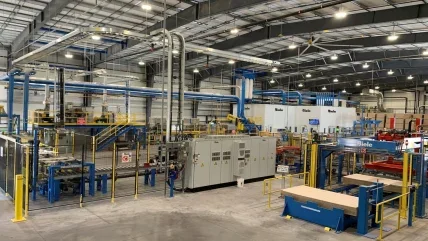
Biele’s high-speed and accuracy handling technology, EVO, has been used for many years for high demanding production lines in various sectors of the wood industry.
This technology was originally developed for the metal division of the Group, for the accurate and high-speed stacking of blanks for automotive tier one manufacturers.
When car manufacturers started to use aluminium or stainless steel instead of original ferric steel sheets, the traditional magnetic stackers used for the handling of the blanks were replaced by vacuum technology and Biele introduced the EVO technology for the first time.
The synergies between the different sectors within Biele then facilitated the evolution of the technology into some operations of the wood and building sector customers that traditionally had been carried out by other type of systems.
In the newest generation of EVO, presented during Ligna in Hannover in May this year, Biele has upgraded the system in a way that now becomes an all-in-one system for feeding, transferring and stacking different type of substrates.
By means of the new EVO, the machine can get an output of 40-50 cycles/min of continuous production. The system is able to feed one or multiple panels in the width with a controlled gap in between them – as an example, for feeding and stacking to and from a high-speed painting line.
Biele says the feeding, stacking, and positioning accuracy can reach +/- 1 mm tolerances.
The machine is also able to play the role of an automatic out-sorting system for B quality or defect panels with high speed and compact footprint. Typically, these are complemented with another EVO machine, to be able to in-sort A quality pieces to the flow. This is necessary to create a complete layer again in case the pieces need to be stacked after the out-sorting machine.
The final configuration of the EVO is customised for each customer and function. In a typical setting the machine is designed with two vacuum arms, one of them being in a fixed position and the second being adjustable in a way that can handle different lengths and widths of substrates according to the recipe and with the use of the HMI.
The EVO machine, following Biele’s philosophy of energy saving and optimisation in all its designs, is demanding lower energy consumption.
These energy savings are obtained by means of different concepts:
- Fewer moving parts: Compared to traditional feeders and stackers, the EVO system needs to move minimum parts to transport any panel instead of moving traditional vacuum heads (consequently needing bigger installed power and energy consumption).
- Controlled vacuum: The design of the system means it requires a very low vacuum force compared to traditional systems for the handling of the same products. In addition to this, the frequency drives installed in the turbines allows the adjustment of the vacuum according to the requirement (material, porosity, weight, shape…) of each piece. Biele Digital, a company within the Biele group, developed software to monitor the vacuum need for each substrate and automatically adjust the system accordingly in real time.
Biele says energy saving has been measured and checked in different applications, reaching reduction rates up to 50% compared to the conventional handling systems used for the same applications.
This new generation of EVO machines is opening new paths in multiple applications where the flexibility, high speed and accuracy of the system is helping Biele’s customers to reduce costs and become more competitive in their markets worldwide.






